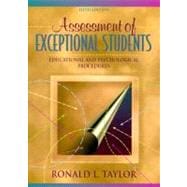
Note: Supplemental materials are not guaranteed with Rental or Used book purchases.
Purchase Benefits
What is included with this book?
| Preface | ix | ||||
| PART ONE Introduction to Assessment: Issues and Concerns | 1 | (62) | |||
|
3 | (20) | |||
|
4 | (7) | |||
|
11 | (2) | |||
|
13 | (8) | |||
|
21 | (2) | |||
|
23 | (24) | |||
|
23 | (7) | |||
|
30 | (2) | |||
|
32 | (9) | |||
|
41 | (1) | |||
|
42 | (2) | |||
|
44 | (1) | |||
|
44 | (2) | |||
|
46 | (1) | |||
|
47 | (16) | |||
|
47 | (14) | |||
|
61 | (2) | |||
| PART TWO Informal Procedures: Basic Tools for Teachers | 63 | (92) | |||
|
65 | (25) | |||
|
66 | (12) | |||
|
78 | (1) | |||
|
79 | (2) | |||
|
81 | (6) | |||
|
87 | (3) | |||
|
90 | (24) | |||
|
90 | (10) | |||
|
100 | (13) | |||
|
113 | (1) | |||
|
114 | (17) | |||
|
115 | (5) | |||
|
120 | (8) | |||
|
128 | (2) | |||
|
130 | (1) | |||
|
131 | (24) | |||
|
132 | (2) | |||
|
134 | (3) | |||
|
137 | (1) | |||
|
138 | (8) | |||
|
146 | (6) | |||
|
152 | (2) | |||
|
154 | (1) | |||
| PART THREE Assessment of Abilities | 155 | (112) | |||
|
157 | (24) | |||
|
158 | (2) | |||
|
160 | (17) | |||
|
177 | (3) | |||
|
180 | (1) | |||
|
181 | (25) | |||
|
183 | (19) | |||
|
202 | (3) | |||
|
205 | (1) | |||
|
206 | (36) | |||
|
207 | (1) | |||
|
208 | (11) | |||
|
219 | (4) | |||
|
223 | (3) | |||
|
226 | (2) | |||
|
228 | (2) | |||
|
230 | (7) | |||
|
237 | (4) | |||
|
241 | (1) | |||
|
242 | (25) | |||
|
244 | (3) | |||
|
247 | (14) | |||
|
261 | (4) | |||
|
265 | (2) | |||
| PART FOUR Assessment of Achievement | 267 | (114) | |||
|
269 | (41) | |||
|
270 | (3) | |||
|
273 | (23) | |||
|
296 | (2) | |||
|
298 | (10) | |||
|
308 | (2) | |||
|
310 | (26) | |||
|
312 | (1) | |||
|
312 | (6) | |||
|
318 | (12) | |||
|
330 | (2) | |||
|
332 | (2) | |||
|
334 | (2) | |||
|
336 | (22) | |||
|
337 | (8) | |||
|
345 | (8) | |||
|
353 | (4) | |||
|
357 | (1) | |||
|
358 | (23) | |||
|
361 | (8) | |||
|
369 | (2) | |||
|
371 | (4) | |||
|
375 | (4) | |||
|
379 | (2) | |||
| PART FIVE Special Assessment Considerations | 381 | (110) | |||
|
383 | (31) | |||
|
384 | (17) | |||
|
401 | (12) | |||
|
413 | (1) | |||
|
414 | (44) | |||
|
417 | (2) | |||
|
419 | (2) | |||
|
421 | (13) | |||
|
434 | (1) | |||
|
435 | (7) | |||
|
442 | (3) | |||
|
445 | (11) | |||
|
456 | (2) | |||
|
458 | (33) | |||
|
|||||
|
|||||
|
459 | (2) | |||
|
461 | (4) | |||
|
465 | (18) | |||
|
483 | (6) | |||
|
489 | (2) | |||
| PART SIX Examples | 491 | (16) | |||
|
493 | (14) | |||
|
493 | (9) | |||
|
502 | (4) | |||
|
506 | (1) | |||
| Appendix A: Process Instruments (Instruments Used for Measuring Processing Skills) | 507 | (5) | |||
| Appendix B: Instruments for Measuring Traumatic Brain Injury | 512 | (3) | |||
| Appendix C: Definition and Assessment Profiles for Selected Categories | 515 | (4) | |||
| Appendix D: Functional Behavior Assessment Form | 519 | (5) | |||
| Appendix E: Cognitive Measures for Special Populations | 524 | (4) | |||
| References | 528 | (32) | |||
| Author Index | 560 | (9) | |||
| Subject Index | 569 | (7) | |||
| Test Index | 576 |
The New copy of this book will include any supplemental materials advertised. Please check the title of the book to determine if it should include any access cards, study guides, lab manuals, CDs, etc.
The Used, Rental and eBook copies of this book are not guaranteed to include any supplemental materials. Typically, only the book itself is included. This is true even if the title states it includes any access cards, study guides, lab manuals, CDs, etc.